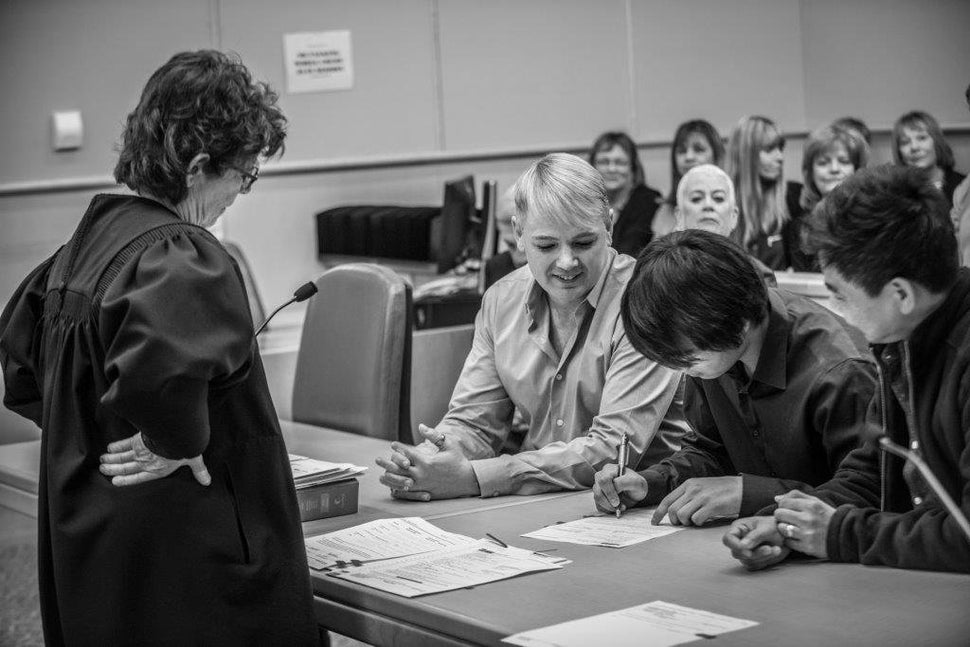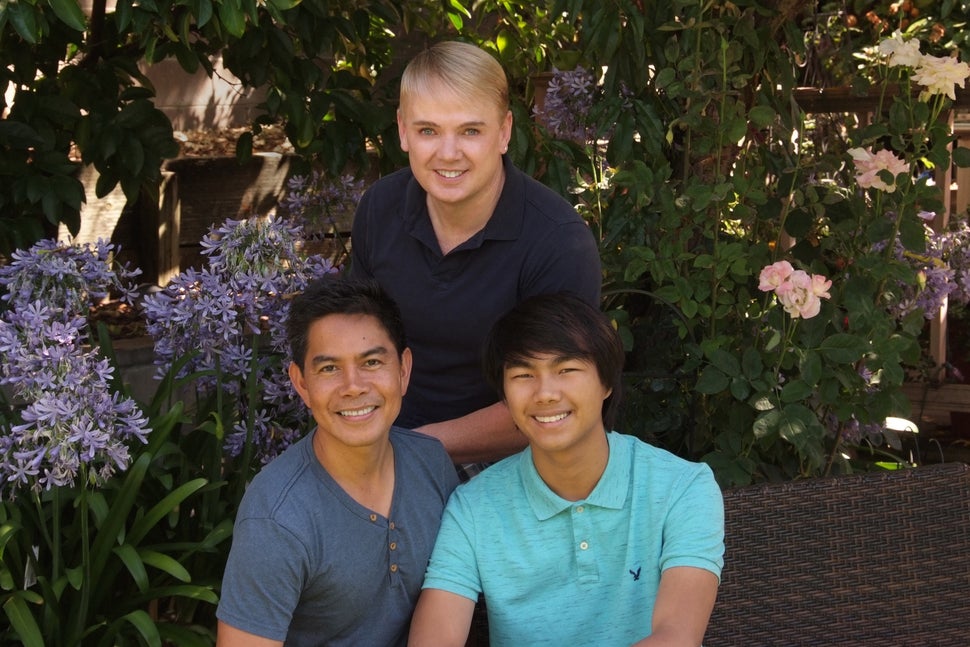
The day that changed the course of Jon Cardoza’s life started out as a fairly ordinary one. He’d gotten in trouble at school – again – and was sitting down over sandwiches that afternoon to endure yet another lecture from his mentor.
“That was the day he popped the question,” Jon recalls now, more than a year later. “He was like, ‘Oh my gosh, you are so frustrating; I should just adopt you.’”
At 16 years old, Jon had given up on the idea that he would ever be adopted. He’d spent the first dozen years of his life enduring abuse and neglect from biological family members. After several reports from teachers and neighbors of suspected abuse, he was removed from the home and spent the next several years bouncing around the foster care system. One of the only constants in his life had been Tom Bauer, a 50-year-old man who’d been reluctantly trained to be an advocate for children in foster care and had taken on Jon’s case when Jon was 12 years old.
Bauer had no intention of becoming a Court-Appointed Special Advocate (CASA), even when two acquaintances who worked for the local CASA organization in San Mateo County, Calif. insisted they saw qualities in him that would make him a good fit for the role.
“I laughed and said, ‘You’re out of your mind,’” said Bauer, who works as a vice chancellor for the San Mateo County Community College District. “I have no patience for kids, I’ve never had a child, and I never wanted a child.”
But when one of those acquaintances offered to go through the training process along with him, he relented.
“I finally convinced myself that I would go through the training, but I wouldn’t actually take a case,” he said.
The need for CASAs
There are more than 400,000 children in the United States’ foster care system at any given time and only 280,000 have an assigned CASA – or guardian ad litem (GAL), as they’re called in some areas. These volunteers advocate in the child’s best interest to prevent them from becoming lost in an overburdened system. The need, therefore, has always been great. Yet experts say this country’s opioid epidemic is already responsible for an increase in the number of children in care ― the number of children in care has risen for three years in a row, thanks largely to parental substance abuse ― a problem that is only expected to get worse.
“We read in the news about the most egregious cases of abuse, but most children enter the child welfare system because of neglect,” said Patricia Bresee, vice chair of the board of trustees for the National CASA Association. “When you have a drug epidemic such as this, you’re going to see more and more of those cases.”
There are more than 400,000 children in the United States’ foster care system at any given time and only 280,000 have an assigned CASA.
That’s why the demand for quality advocates, as well as trained foster parents and dedicated adoptive parents, is both critical for children in care and on the rise. There simply aren’t enough to go around; there are barely 86,000 CASA and GAL volunteers working with the aforementioned 280,000 kids, leaving more than 120,000 without any court-appointed advocates at any given time.
Bauer is among the rare breed who committed to all three roles for one child, starting first as Jon’s CASA. Over the course of several years, Bauer got an up-close view at the inner workings of a system stretched too thin, and he came to understand the level of commitment needed by children who are often overlooked and underserved.
“The resources are limited,” Bauer said. “The schools assumed he wouldn’t be a good student and were little help. His executive-level functioning, the brain function that controls task management, did not form completely because of what he had to deal with at such a young age. But I knew Jon was very smart ... I would make up what he needed.”
CASA’s national organization is the only one of its kind that supports and promotes this level of volunteer court-appointed advocacy. But with limited federal funding and grant opportunities and 943 chapters spread across the United States, it’s largely up to local state and county governments, as well as private donors, to provide the financial resources needed for outreach and training. The result is that the quality and effectiveness of the local organizations can vary widely from state to state and county to county.
“In some areas, the CASAs only see the kids at court,” said Patricia Miljanich, executive director of CASA of San Mateo County. “The norm is to see the kids once a month. In our program, we ask them to see them once a week.”
Bresee calls the San Mateo chapter “one of the great models for CASA,” and is in part so successful because of the wealthy private donor base it has to draw on. It serves nearly half of the county’s approximately 700 foster children, largely with each CASA taking on just one case, allowing them more time to dedicate to connecting with and advocating for each child. As Miljanich points out, it also takes a tenacity and dedication on the part of the volunteer to work with ― not against ― the social workers, foster parents, attorneys and judges assigned to a child’s case.
“The focus is always on the child,” Miljanich said. “It’s about what the child needs and how it’s going to happen.”
From CASA to ‘Dad’
After Bauer completed his CASA training, he sat in a room with a stack of five files of different cases for him to consider, still not expecting to actually choose one. Jon’s file was on top.
“CASA does a very good job in their first orientation session of telling you what you’ll be getting yourself into,” Bauer said. “But Jon’s history was worse than anything they’d even told us about in training. I looked at the other four files, but after reading about Jon, I knew I wanted to work with him.”
That didn’t stop Bauer from feeling, as he described, “terrified” before their first meeting when Jon was 12 years old.
“He hid under the table most of the time,” Bauer said. “When he did talk, he didn’t make much sense.” But when Bauer pulled out the game Connect 4, Jon sat down and began to play. Two hours later, Jon had won almost every game.
Over the course of the next five years, the bond between Bauer and Jon grew. They went to restaurants, movies and the beach together. In court, Bauer pushed for better therapeutic resources; in school, Bauer worked directly with administrators to manage academic and behavioral issues. In the meantime, Jon moved from one foster parent to another, neither of which could or would make the long-term commitment to adopt him.

Most CASAs don’t go on to adopt the children they advocate for, but as the years went by, Bauer saw how Jon continued to struggle. Without a strong family support system, Bauer said he began to worry about the path Jon’s future would take. He began talking with his husband, Nilo Ventura, about the possibility of adoption. Ventura, who’d had very limited contact with Jon, was hesitant. It would take a lot of catching up for him to develop the same bond that Bauer had with Jon, and it would mean a major lifestyle change for the couple.
“I guess you could say we were a typical gay couple,” Bauer said. “We were successful, we had money, and up until this point, my biggest contribution to society was rescuing pugs. We had a good social circle, we’d go to shows and bars, and we’d travel to see family and friends.
“But Nilo knows me pretty well, and he knows that when I go into something, I go all in.”
Jon moved in with Bauer and Ventura in July of 2016 as their foster child before the adoption was finalized in March 2017. The ceremony was attended by 75 family members, co-workers and friends of the couple, as well as Jon’s former foster parents and social workers. Jon is now a junior and attends a small Montessori high school with a heavy focus on student collaboration and college prep. His grades are up, he is taking honors classes, and he has his sights set on a career in computer science or graphic design.
Jon and Ventura, who share a Filipino heritage, have bonded over Filipino food, their similarly shy nature and their love of the five rescued pugs that share their home. While Jon calls Bauer “Dad,” he calls Ventura “Tatay,” which means “father” in the Filipino language. They all have settled into their new life as a family of three with family dinners, movie nights and church on Sundays.
“I used to feel like family is just people you’re related to because I didn’t really have a caring family like this,” Jon said. “I was really surprised at how open they are, and I’m really happy to be part of their family. I didn’t change but I feel different (since the adoption was finalized). I’m more happy and more self-confident.”
Bresee credits the relationship the couple have built with Jon as a main factor in his increasing success.
“The most important factor in the success and growth of a child is having a strong connection with at least one adult,” Bresee said. “A parent, a mentor, a relative, a teacher or a coach; every child needs someone who has really helped formed the core of who they are.”